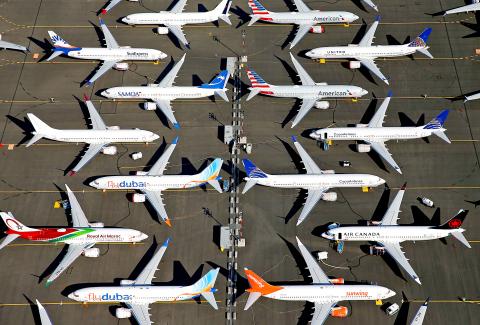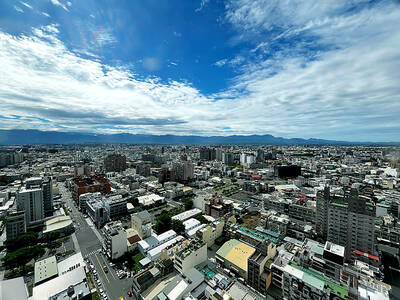As Boeing Co sets its sights on winning approval to fly its 737 MAX within weeks, following a six-month safety ban, engineers around the world are rolling out plans for one of the biggest logistical operations in civil aviation history.
Inside Boeing’s 737 factory in Renton, Washington, south of Seattle, workers have preassembled dedicated tool kits for technicians tasked with installing software updates and readying more than 500 jets that have sat idle for months, insiders said.
Across the globe, Boeing teams are hammering out delivery schedules — and financial terms — with airline customers who have been forced to cancel flights, cut routes and fly aging jetliners while they await the MAX’s return.

Photo: Reuters
Although regulators must still approve the jets for flight, Boeing and airline staff and executives have said that the world’s largest planemaker is weeks into an elaborate blueprint for production, maintenance and delivery that, according to one source, involves 1,500 engineers — as many as it takes to design a new small jet.
Another likened the logistics to a nation “going to war.”
Boeing Commercial Airplanes chief engineer John Hamilton called the previously unreported mobilization more like an elaborate “ballet,” which includes synchronizing 680 suppliers of everything from carbon brakes to pilot seat belts.
Boeing will have to juggle the delivery of two different MAX categories: about 250 produced since the ban, parked at various facilities in tail-to-nose configurations that conjure the puzzle game Tetris; and those that will roll off the production line post-approval.
Airlines will mostly handle a third category involving the return to service of 387 aircraft flown before the grounding, although Boeing has already deployed teams worldwide to help companies get ready for that process.
Boeing’s fastest-selling jet was grounded in March after flight-control software was found to have played a role in two separate crashes that killed a total of 346 people within five months.
The ban sent shock waves through the aviation industry, cutting Boeing’s profit and margins, with a cost to Boeing so far estimated at US$8 billion.
Smoothly redeploying hundreds of idle 737 MAX aircraft, which bring in an estimated 40 percent of Boeing’s pretax profit, is crucial for the health of the US’ top corporate exporter and the country’s wider manufacturing sector, whose recent loss of momentum has taken a further knock from the crisis.
Boeing receives much of its cash upon delivery, and Fitch Ratings Inc and Moody’s Investors Service have warned that its “stable” outlook might be at risk, as its airplane deliveries have fallen 72 percent this year.
Preparations for a return to service are finely tuned to the company’s present assumption that the 737 MAX will resume commercial flights in the October-to-December time frame, Boeing CEO Dennis Muilenburg told Reuters last month.
However, the timeline is in the hands of divided regulators around the world that must approve Boeing’s proposed software fix for 737 MAX flight controls and new training materials.
European regulators plan their own test flights on the changes.
“We don’t control that timeline,” Muilenburg said. “We are going to work with the regulators and we are making progress towards that timeline, but if that return-to-service date changes, it affects everything else.”
Boeing has told suppliers that it expects the airplane to be flying in early November, a senior industry source said.
Once regulators certify the 737 MAX for flight, Boeing will have to mobilize hundreds of mechanics and pilots to bring the about 250 stored aircraft out of hibernation.
Airlines estimate the process — which includes installing new software, changing fluids and cycling the engines — would take 100 to 150 hours per jet, and months in total for Boeing.
In one example highlighting the minute risks that could upend months of planning, a team of employees is analyzing years of data on snowfall in December at an airport in rural Moses Lake, Washington — where Boeing has parked about 100 jets — to predict demand for aircraft anti-freeze and runway performance.
The maintenance process would be followed by several days of test flights as part of a standard customer acceptance period, but another challenge is finding enough pilots to work through the backlog.
As a result, Boeing is exploring a deal for temporary pilots with Isle of Man-based aircrew and training provider CCL Aviation to supplement its staff pilots, one person with knowledge of the matter said.
“Given the backlog of stored aircraft, that customer acceptance process could drag out,” Southwest Airlines Co chief revenue officer Andrew Watterson said.
It is not clear which customers would receive deliveries first. Much will depend on how quickly other global regulators that have promised their own scrutiny follow the US lead.
Some, like United Airlines Inc, have said that they want the jets as soon as possible, but others might use the opportunity to adjust deliveries.
While airlines had been eager to add the fuel-saving models ahead of the peak northern hemisphere summer, fewer tend to add capacity in the quieter month of November.
The eventual return of the 737 MAX will also test an increasingly fragile aviation market.
Traffic growth has slipped since the grounding, partly as a result of global trade tensions, the International Air Transport Association said.
Muilenburg has played down concerns about airline demand, telling a conference this week that the market remains robust.
However, of 250 stored jets, about a dozen are bound for lessors that have yet to place them with airlines, or were built for now-bankrupt carriers like Jet Airways (India) Ltd, industry sources said.
Analysts have said that some airlines might try to use the grounding as a smokescreen to try to cancel orders, something Boeing would resist.
Boeing will nonetheless face conflicting demands over how fast airlines are now prepared to grow their fleets, said Rob Morris of UK-based aviation consultancy Ascend by Cirium.
“Once the MAX logjam is broken ... there are a lot of aircraft that are potentially surplus,” he added.

BYPASSING CHINA TARIFFS: In the first five months of this year, Foxconn sent US$4.4bn of iPhones to the US from India, compared with US$3.7bn in the whole of last year Nearly all the iPhones exported by Foxconn Technology Group (富士康科技集團) from India went to the US between March and last month, customs data showed, far above last year’s average of 50 percent and a clear sign of Apple Inc’s efforts to bypass high US tariffs imposed on China. The numbers, being reported by Reuters for the first time, show that Apple has realigned its India exports to almost exclusively serve the US market, when previously the devices were more widely distributed to nations including the Netherlands and the Czech Republic. During March to last month, Foxconn, known as Hon Hai Precision Industry

Taiwan Semiconductor Manufacturing Co (TSMC, 台積電) and the University of Tokyo (UTokyo) yesterday announced the launch of the TSMC-UTokyo Lab to promote advanced semiconductor research, education and talent development. The lab is TSMC’s first laboratory collaboration with a university outside Taiwan, the company said in a statement. The lab would leverage “the extensive knowledge, experience, and creativity” of both institutions, the company said. It is located in the Asano Section of UTokyo’s Hongo, Tokyo, campus and would be managed by UTokyo faculty, guided by directors from UTokyo and TSMC, the company said. TSMC began working with UTokyo in 2019, resulting in 21 research projects,

Taiwan’s property market is entering a freeze, with mortgage activity across the nation’s six largest cities plummeting in the first quarter, H&B Realty Co (住商不動產) said yesterday, citing mounting pressure on housing demand amid tighter lending rules and regulatory curbs. Mortgage applications in Taipei, New Taipei City, Taoyuan, Taichung, Tainan and Kaohsiung totaled 28,078 from January to March, a sharp 36.3 percent decline from 44,082 in the same period last year, the nation’s largest real-estate brokerage by franchise said, citing data from the Joint Credit Information Center (JCIC, 聯徵中心). “The simultaneous decline across all six cities reflects just how drastically the market

Ashton Hall’s morning routine involves dunking his head in iced Saratoga Spring Water. For the company that sells the bottled water — Hall’s brand of choice for drinking, brushing his teeth and submerging himself — that is fantastic news. “We’re so thankful to this incredible fitness influencer called Ashton Hall,” Saratoga owner Primo Brands Corp’s CEO Robbert Rietbroek said on an earnings call after Hall’s morning routine video went viral. “He really helped put our brand on the map.” Primo Brands, which was not affiliated with Hall when he made his video, is among the increasing number of companies benefiting from influencer